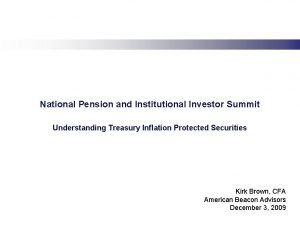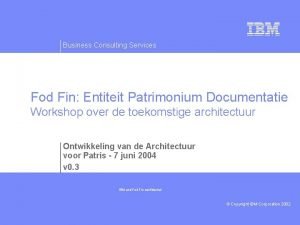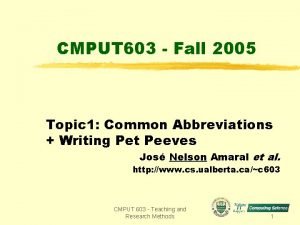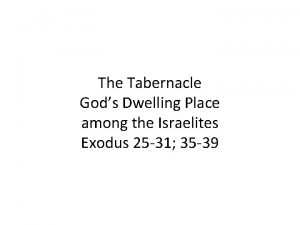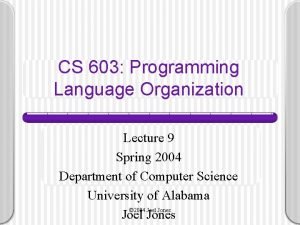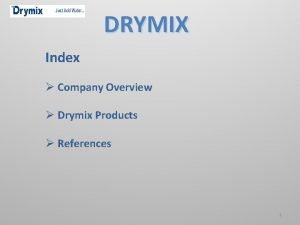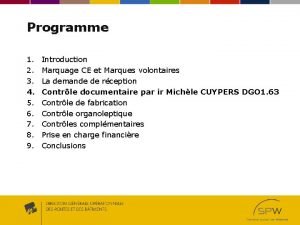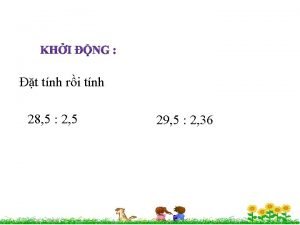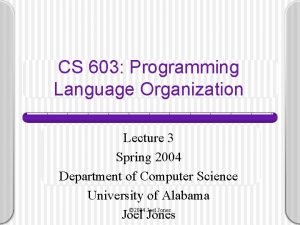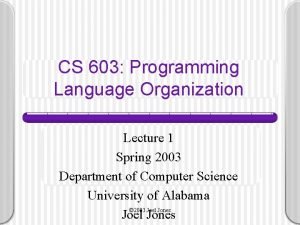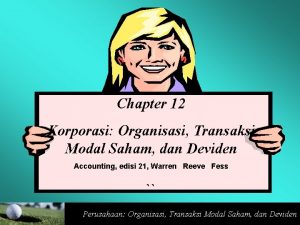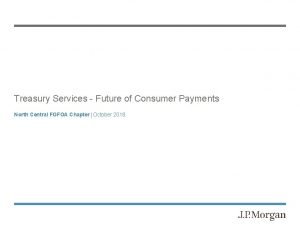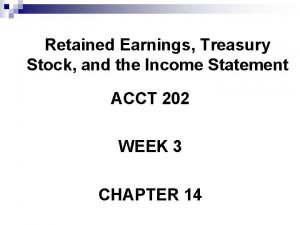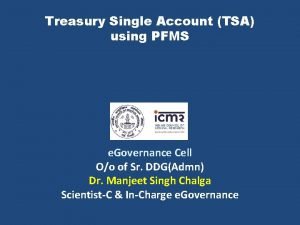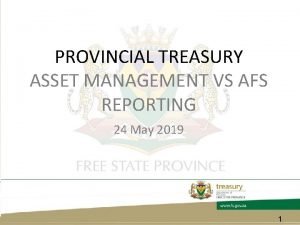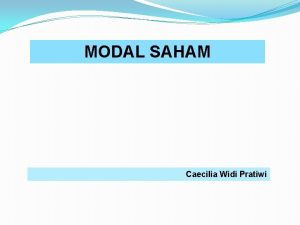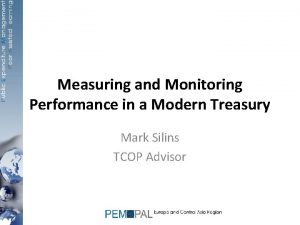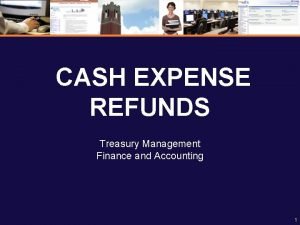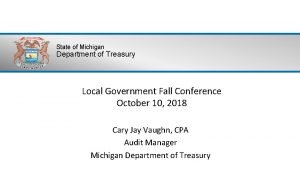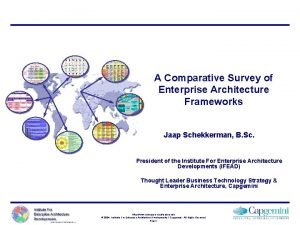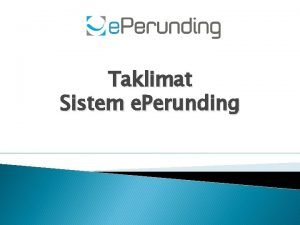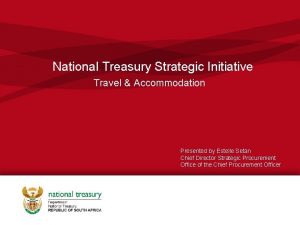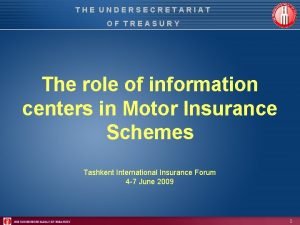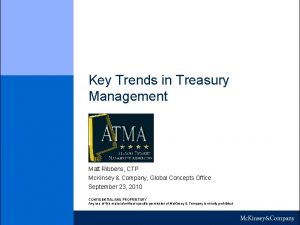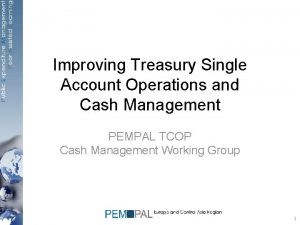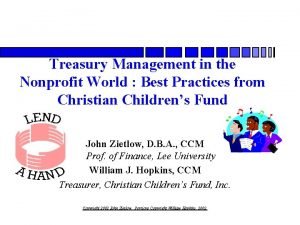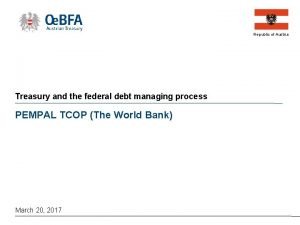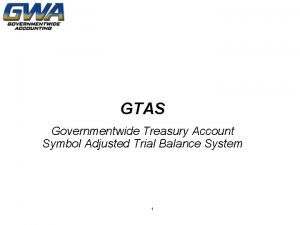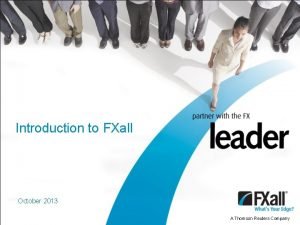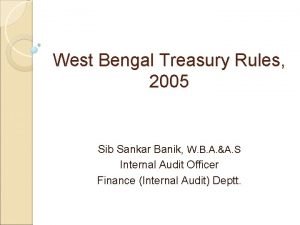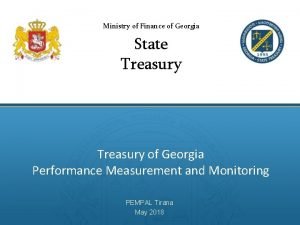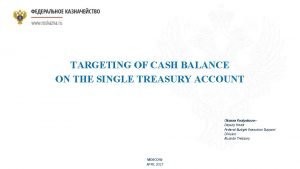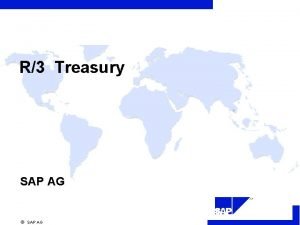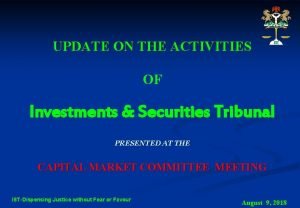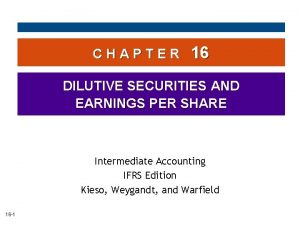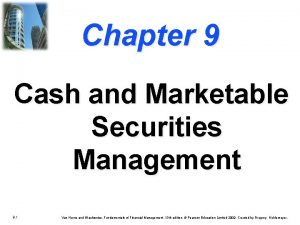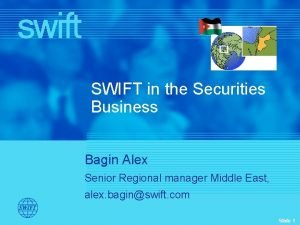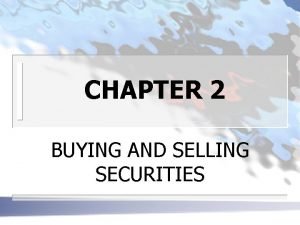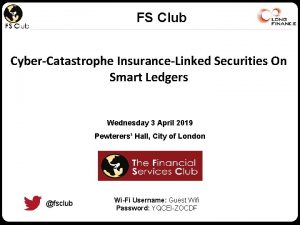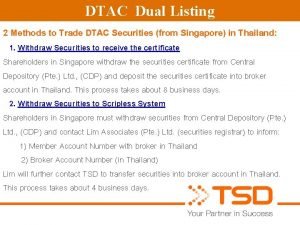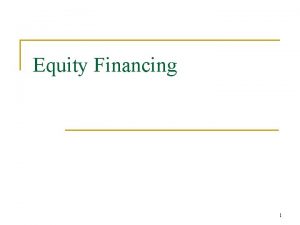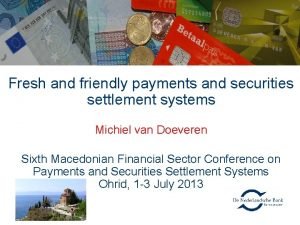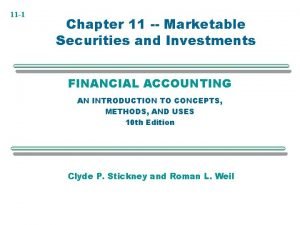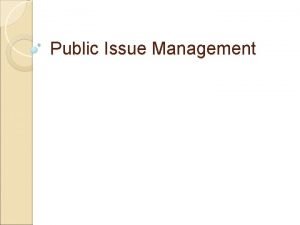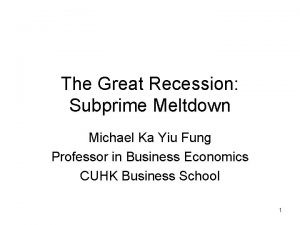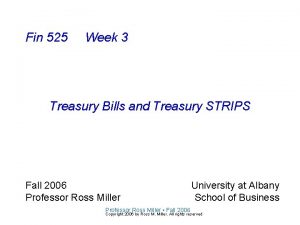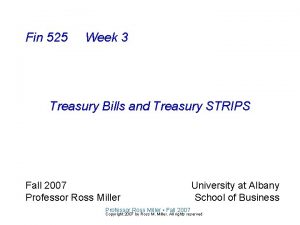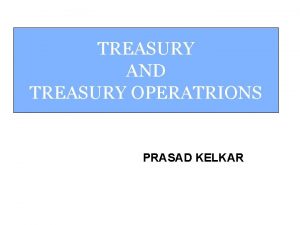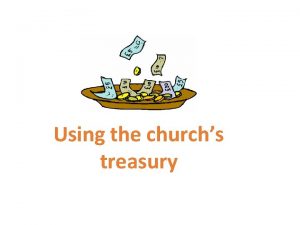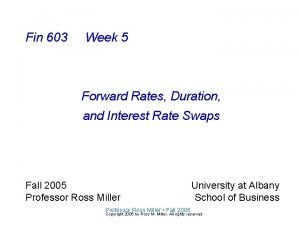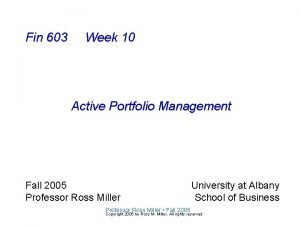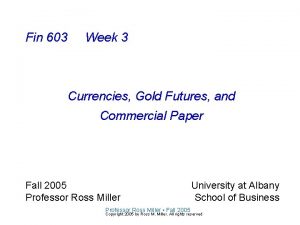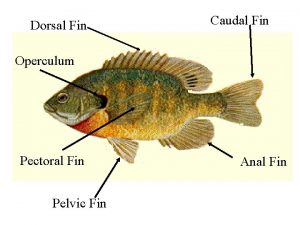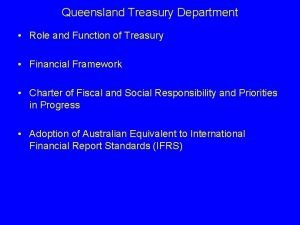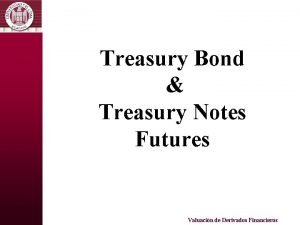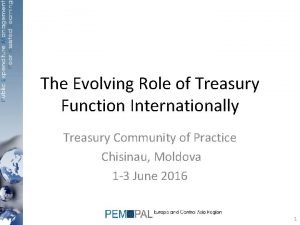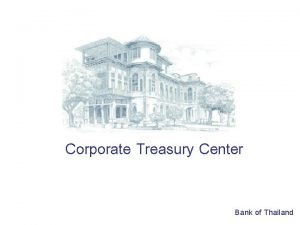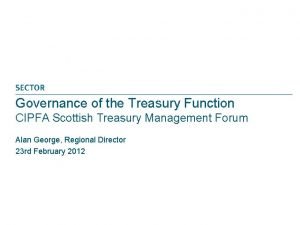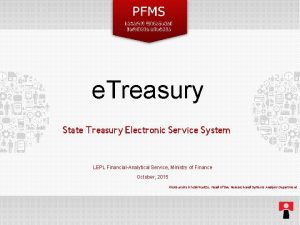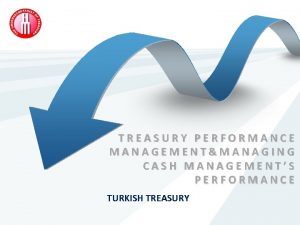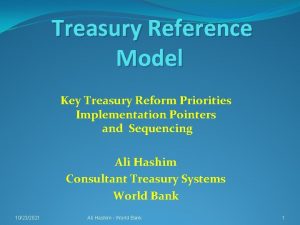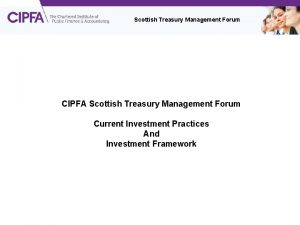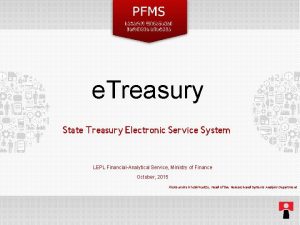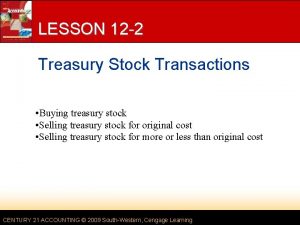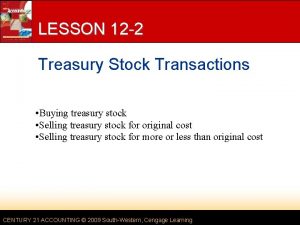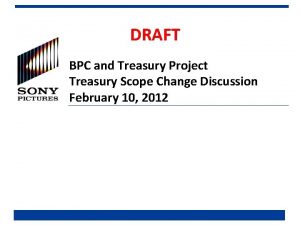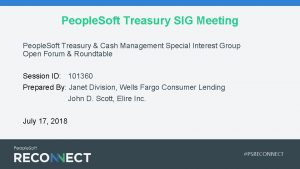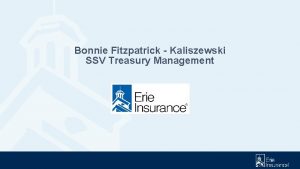Week 4 Fin 603 U S Treasury Securities





























































- Slides: 61

Week 4 Fin 603 U. S. Treasury Securities: Bills, STRIPS, Notes, Bonds, and TIPS Fall 2005 Professor Ross Miller • Fall 2005 University at Albany School of Business Copyright 2005 by Ross M. Miller. All rights reserved

(13 -week and 26 -week) U. S. Treasury Bills Ø Short-term securities issued by the U. S. Treasury to finance the national debt Ø As good as cash for many purposes • Margin in brokerage accounts • Transfer of funds between corporations Ø Extremely liquid • Easy to purchase electronically • Easy to buy and sell through brokers & dealers • Easy to lend to others for short periods of time (repurchase agreements or repos) Professor Ross Miller • Fall 2005 1

Continuous T-Bill Quotes from Bloomberg (Free) Professor Ross Miller • Fall 2005 2

Daily T-Bill Quotes from e. Speed from the Wall Street Journal (subscription required) Market Close 9/9/2005 Professor Ross Miller • Fall 2005 3

Why T-Bills Can Pay Less Interest Than Eurodollars Ø Exempt from state and local taxes Ø The U. S. Treasury is considered the least risky financial institution in the world (the top credit rating is AAA, the U. S. Treasury is considered by some to be AAAA) Professor Ross Miller • Fall 2005 E=mc 2 4

T-Bill Yields are Quoted Using the Same Method as Commercial Paper Ø At a discount from face value Ø Using a 360 -day year Professor Ross Miller • Fall 2005 E=mc 2 5

Let’s See What It Costs to Buy $10, 000 Face Value of The T-Bill That Matures in 45 Days Ø The ask yield is 3. 25% Ø Based on a 360 -day year, 45 days is 1/8 of a year Ø The “discount” for the bond is 1/8 x 3. 25% = 0. 40625% Ø Applying the discount to $10, 000 gives. 0040625 x $10, 000 = $40. 625 (rounded up to $40. 63) Ø The final cost is $10, 000 – $40. 63 = $9, 959. 37 Professor Ross Miller • Fall 2005 E=mc 2 6

Microsoft Excel Note Ø Excel contains various T-Bill functions • TBILLYIELD (computes discount yield) • TBILLPRICE (compute T-bill price) • TBILLEQ (computes effective yield) Ø There are similar Excel function for other Treasury securities and bonds in general, you are free to explore them on your own Ø In practice, services like Bloomberg provide these automatically to professional Professor Ross Miller • Fall 2005 E=mc 2 7

The TED (Treasury-Eurodollar) Spread Ø The difference in yield between the three-month Eurodollar (LIBOR) and the three-month T-bill Ø The TED spread is considered a credit-risk indicator and is easy to trade with futures Ø Example from 9/9/2005 • • 3 -month Eurodollar yield: 3. 85% 3 -month (90 -day) T-bill yield 3. 48% TED spread is 37 b. p. Why? 3. 85% – 3. 48% = 0. 37% (also known as 37 basis points—written 37 b. p. and pronounced “ 37 bips”) Professor Ross Miller • Fall 2005 8

Repurchase Agreement (Repo) Ø Deals with the problem that T-bills are only issued every 7 days Ø To create a “custom maturity” for a T-bill, a dealer will “rent it out” for the desired period of time, often just overnight • The actual mechanics are that the dealer sells the T-bill and agrees to “repurchase” it on a specified date at a higher price • The “renter” is said to have a reverse repurchase agreement and has the T-bill as collateral Ø T-bills are not the only securities that are “repoed, ” but are the most popular Professor Ross Miller • Fall 2005 9

Anatomy of a 5 -year Treasury Note with a 3. 50% Coupon Rate $1, 000 Principal Payable 8/15/09 $17. 50 Coupon Payable 2/15/05 $17. 50 Coupon Payable 8/15/05 $17. 50 Coupon Payable 2/15/06 $17. 50 Coupon Payable 8/15/06 $17. 50 Coupon Payable 2/15/07 $17. 50 Coupon Payable 8/15/07 $17. 50 Coupon Payable 2/15/08 $17. 50 Coupon Payable 8/15/08 $17. 50 Coupon Payable 2/15/09 $17. 50 Coupon Payable 8/15/09 Professor Ross Miller • Fall 2005 10

Treasury STRIPS Ø Stands for Separate Trading of Registered Interest and Principal of Securities and is an example of a “pure discount bond” Ø They are the principal and coupon payments “stripped” from U. S. Treasury notes and bonds Ø Treasury notes and bonds can be “reconstituted” from STRIPS Ø They generate cash flows like T-bills; however, they can have maturities out as far as 30 years Professor Ross Miller • Fall 2005 11

More on Treasury STRIPS Ø Two differences from Treasury bills • Quoted as a price rather than as an annualized discount • Even though payments are only made on maturity, taxes are assessed annually on the accrued interest Ø Often referred to as “Treasury zero-coupon bonds” or “Treasury zeroes” and treated like original-issue discount (OID) securities Ø Created in 1985 by U. S. Treasury in response to separate trading of treasury security principal and interest developed by securities firms, most notably Merrill Lynch Professor Ross Miller • Fall 2005 12

The Three Types of STRIPS Ø ci – Coupon Interest: Coupon payment from either a note or bond Ø np – Note Principal: Principal payment from a specific Treasury note (a Treasury security issued with a maturity of 2 to 10 years) Ø bp – Bond Principal: Principal payment from a specific Treasury bond (a Treasury security issued with a maturity of more than 10 years) Professor Ross Miller • Fall 2005 13

CUSIPs Ø They are lots of STRIPS, sometimes several with the same maturity date, so there has to be an easy way to tell them apart Ø CUSIPs are unique securities identifiers that not just Treasury STRIPS, but all securities are assigned Ø They are the industry standard way to identify fixed-income securities Ø Although stocks and mutual funds also have CUSIPs, ticker symbols (like GOOG for Google) are more commonly used to identify them Professor Ross Miller • Fall 2005 14

Getting Prices for STRIPS Ø Although easy to buy and sell from major brokers, they are difficult to get quotes on Ø Yahoo! Finance has quotes through its bond screener (simply check “Treasury Zero Coupon” and then click on the “Find Bonds” button); however, those prices are highly unreliable Ø The Wall Street Journal only prints those with maturities of ten years or less and has nothing online Ø STRIPS are usually quoted in 32 nds Professor Ross Miller • Fall 2005 15

Quotes for 9/16/2005 from the Wall Street Journal Print Edition Professor Ross Miller • Fall 2005 16

A Detailed Look at a STRIPS Quote (Feb 06) Matures February 15, 2006 (ci) Is a coupon payment (Bid 98: 19 and Ask 98: 19) Has both a bid and ask price of 98 and 19/32, which is 98. 59375 (Yld 3. 50) Has a yield (calculated on a bondequivalent basis) of 3. 50% Note: The maturity price is 100 Professor Ross Miller • Fall 2005 E=mc 2 17

Quotes From the Bottom of the 9/16/05 Table Professor Ross Miller • Fall 2005 18

Rule of 72 Ø For bonds with “normal” interest rates, the time it takes to double money is approximately 72 divided by the interest rate in percentage terms Ø Examples of this “rule”: • At a 10% APY, it takes about 7. 2 years for money to double • Conversely, if you want your money to double in 10 years, you need to receive an APY of approximately 7. 2% Professor Ross Miller • Fall 2005 E=mc 2 19

General Formula for Valuing Pure Discount Bonds with T Years to Maturity Ø F is face value (same as the FV we used before) Ø T is time (in years) to maturity and can include fractional year— 10 years and 2 months (the time until expiration for the Nov 2015 STRIPS would give T=10. 1666… Professor Ross Miller • Fall 2005 E=mc 2 20

Calculating the PV for a STRIP with r = 4. 43% and T = 10. 1666 PV = F/(1+r)T = 100/(1+0. 0443)10. 1666 = 100/1. 5538 = 64. 36 Notice that this does not match the ask price of 64: 04, which is 64 4/32 or 64. 125. This is because yields on STRIPS are quoted so that they are comparable to bonds that pay interest semi-annually Professor Ross Miller • Fall 2005 E=mc 2 21

Yield to Maturity (Sneak Preview) Ø Since bonds trade based on prices, not yields, it is useful to be able to compute a bond’s yield from its price, time to maturity, and par (or redemption) value Ø For simple values of T (1 year or 2 years) the yield can be found directly from the pure discount bond formula (or using logarithms for less simple values) Ø For bonds with coupon payments, no direct formula is available Professor Ross Miller • Fall 2005 E=mc 2 22

The “Gotcha” with STRIPS Ø STRIPS would appear to be an ideal tax shelter —no taxable interest, just a giant capital gain at maturity Ø The IRS figured this angle out some time ago • All OIDs (original-issue discount bonds) have their discount amortized over the life of the bond • This is the worst of both worlds, the only cash flow you get is at maturity, but you are taxed on annual basis for cash you do not receive Ø STRIPS are mainly useful for tax-sheltered or foreign investments Professor Ross Miller • Fall 2005 23

Why STRIPS are So Important Ø Using STRIPS financial institutions can create risk-free securities with any sequence of cash flows that they or their clients desire Ø There are other ways to approximate securities using duration and convexity analysis (we will get to this), but STRIPS replicate risk-free cash flows exactly Professor Ross Miller • Fall 2005 24

The Sensitivity of STRIPS Prices to Changes in Interest Rates Ø Like all bonds, the value of a STRIP goes down when interest rates increase and goes up when they decrease Ø As the time to maturity (T) of a STRIP increase, so does its sensitivity to changes in interest rates Ø This is a direct consequence of the formula for the pure discount bond formula—higher values of T means bigger changes in PV for the same change in r Professor Ross Miller • Fall 2005 E=mc 2 25

An Overview of the Bond Markets Ø A bond is a promise to make periodic coupon payments and to repay principal at maturity— breech of this promise is an event of default Ø Bonds carry original maturities greater than one year, so bonds are instruments of the capital markets Ø Bonds issued with maturities of 10 years or less are sometimes called notes Ø Issuers are corporations and government units Professor Ross Miller • Fall 2005 E=mc 2 26

Bonds are Bundles of Cash Flows Ø Bonds can be viewed as a “bundle” of zerocoupon securities—Treasury bonds are literally bundles of STRIPS Ø New cash flow scheme • Cash flows out now to buy the security • Cash flows in several times until the security matures • Later, we will incorporate options that can accelerate the payments at the borrower’s discretion Professor Ross Miller • Fall 2005 E=mc 2 27

Treasury Notes and Bonds Ø T-notes and T-bonds issued by the U. S. Treasury to finance the national debt and other federal government expenditures Ø Backed by the full faith and credit of the U. S. government and are essentially default risk free Ø Have significant interest-rate risk due to their longer maturities Ø Pay interest twice a yield (interest payments are at half the “coupon rate”) Professor Ross Miller • Fall 2005 28

Anatomy of a 5 -year Treasury Note with a 3. 50% Coupon Rate $1, 000 Principal Payable 8/15/09 $17. 50 Coupon Payable 2/15/05 $17. 50 Coupon Payable 8/15/05 $17. 50 Coupon Payable 2/15/06 $17. 50 Coupon Payable 8/15/06 $17. 50 Coupon Payable 2/15/07 $17. 50 Coupon Payable 8/15/07 $17. 50 Coupon Payable 2/15/08 $17. 50 Coupon Payable 8/15/08 $17. 50 Coupon Payable 2/15/09 $17. 50 Coupon Payable 8/15/09 Professor Ross Miller • Fall 2005 E=mc 2 29

“On-the-Run” (Most Recently Issued) Treasury Notes and Bonds on 9/21/2005 Professor Ross Miller • Fall 2005 30

Bond Complications Ø Bond prices are given using a par value of 100 Ø Bonds are traded in multiples of $1, 000, so “one bond” typically represents a principal amount of $1, 000 Ø While Treasury securities do routinely trade in multiples of $1, 000, many corporate bonds only trade in multiples of $1, 000 or $5, 000 Ø Like STRIPS, quotes are normally in 32 nds Professor Ross Miller • Fall 2005 E=mc 2 31

What Is Easy and What Is Difficult about Bonds Ø Finding a present value (PV) is easy • The present value of the bond is just the sum of the present values of every cash flow it generates • With regular coupon payments, annuity factors make this a snap to do Ø Finding the future value (FV) is difficult • The obvious point in time to seek an FV for the bond is at its maturity • The problem is what happens to all the cash flows received before then • This problem is known as “reinvestment risk” and certain assumptions (often unrealistic) are used to attempt to deal with it Professor Ross Miller • Fall 2005 E=mc 2 32

Why Care About This? Does It Matter? Professor Ross Miller • Fall 2005 ? ? ? 33

Another Difficulty: Bond Yield Ø For a zero-coupon bond, one can find an APY (annual percentage yield) by solving FV=PV(1+r)T for r, which gives: r = (FV/PV)(1/T) – 1 Ø With multiple cash flows, there is no general formula Ø One can use Excel’s (or a financial calculator’s) IRR or YIELD function to compute a yield to maturity (and this is standard practice), but yield to maturity assumes that all cash flows can be reinvested at that yield Professor Ross Miller • Fall 2005 E=mc 2 34

Current Yield vs. Yield to Maturity Ø Current Yield = Annual Coupon Payment/Price Ø Example in BKM, Chapter 14 • 8% coupon, 30 -year bond, price=$1, 276. 76 • Current yield = $80/$1, 276. 76 = 6. 2659% Ø The problem is that in 30 years the bond matures at $1, 000, so $276. 76 is being lost over the 30 years and should be reflected in the yield Professor Ross Miller • Fall 2005 E=mc 2 35

Current Yield vs. Yield to Maturity (continued) Ø Yield to maturity is a way of adjusting yield to account for the expected gain or loss in the bond over its lifetime Ø In the case of the textbook 30 -year bond example, the yield to maturity is the value of r that solves: Professor Ross Miller • Fall 2005 E=mc 2 36

Realized Compound Yield Ø BKM shows how to compute the realized compound yield, which takes into account the projected reinvestment rates for the bond Ø This computation is not frequently used in practice because no one knows what those reinvestment rates are ahead of time with any accuracy Professor Ross Miller • Fall 2005 E=mc 2 37

Par, Premium, and Discount Bonds Ø Bonds that trade at 100 are trading at par • Their yield to maturity is the same as their coupon rate Ø Bonds that trade above 100 are trading at a premium to par • Their yield to maturity is less than their coupon rate because receiving less than the bond’s price at maturity diminishes the interest payments Ø Bonds that trade below 100 are trading at a discount to par • Their yield to maturity is more than their coupon rate because receiving more than the bond’s price at maturity supplements the interest payments Professor Ross Miller • Fall 2005 38

Computing a Bond’s Price from Its Yield Step 1: Listing the Cash Flows Ø We will assume (for now) that the first interest payment occurs in ½ year from now Ø An easy example: 4% coupon rate that matures in 1 year Ø Just two cash flows: • $2 in ½ year (all interest) • $102 in 1 year ($2 interest + $100 principal) Professor Ross Miller • Fall 2005 39

Computing a Bond’s Price from Its Yield: Step 2: Get An Interest Rate Ø Bond payment periods are at ½-year intervals, so use a ½-year (or semiannual) interest rate (but it is usually stated as an annual rate, that is then halved) Ø Suppose the rate is quoted as 5. 00% annually, but is really 2. 50% semi-annually Professor Ross Miller • Fall 2005 40

Computing a Bond’s Price from Its Yield: Step 3: Discount the Cash Flow and Add Up Ø The first cash flow is $2, so discounted at 2. 5%, it is worth $2/(1. 025) = $1. 9512 Ø The second cash flow is $102, so discounted at 2. 5% (twice), it is worth $102/(1. 025)2 = $97. 0851 Ø Add them together to get the bond’s value: $1. 9512 + $97. 0851 = $99. 0363 or about $99. 04 Ø Notice that because the yield is above the coupon rate, the bond trades at a discount Professor Ross Miller • Fall 2005 41

The General Bond Valuation Formula Annuity Factor Professor Ross Miller • Fall 2005 PV Factor E=mc 2 42

Comments on the Bond Pricing Formula Ø Reminder: r is semiannual rate Ø The second term is simply the pure discount bond formula where T is measuring in half-years Ø The first term can be derived using a trick that is explained in the textbook • If the coupon payment is received forever (in perpetuity), the present value of that perpetual stream of cash flows is Coupon. r • We then subtract off the present value of a perpetuity that begins in T periods Professor Ross Miller • Fall 2005 E=mc 2 43

Standard Treasury Bonds are Fixed-Rate Bonds Ø The price of Treasury bonds and other bonds with fixed coupon rates moves inversely with interest rates • Rates up, bonds down • Rates down, bonds up Ø If the coupon rate were to adjust itself to prevailing interest rates, the price of the bond would remain relatively stable Ø We will cover such “floating-rate” bonds next time Professor Ross Miller • Fall 2005 44

Wait! There’s More! Ø Quoted bond prices (such as those on Bloomberg on in the Wall Street Journal) do not include accrued interest since the last coupon payment Ø This is known as the “clean price” Ø Adding in the accrued interest gives the “dirty price” (also known as the sale or invoice price), which is what is really paid for the bond Professor Ross Miller • Fall 2005 E=mc 2 45

Computing Accrued Interest = INT x Actual days since last coupon payment 2 Actual days in coupon period Ø An example: 5. 875% coupon rate, 81 days since last coupon payment and 184 days in coupon period: Accrued interest = (5. 875%/2) x (81/184) = 1. 29314% Professor Ross Miller • Fall 2005 E=mc 2 46

Getting the Dirty Price = Clean Price + Accrued Interest Ø Suppose the bond with the 5. 875% coupon rate trades at 101 -11, which is 101. 34375% of face value, so Dirty price = 101. 34375% + 1. 29314% = 102. 63689% Professor Ross Miller • Fall 2005 E=mc 2 47

TIPS (Treasury Inflation-Protected Securities) Ø Treasury securities with a guaranteed coupon payment and a floating coupon payment tied to the CPI-U (Urban Consumer Price Index) Ø These the securities indicated with an “i” in the Wall Street Journal notes and bonds table Ø The difference between the yield to maturity of a regular Treasury securities and the TIPS with approximately the same maturity provides an indication of expected inflation Professor Ross Miller • Fall 2005 E=mc 2 48

TIPS from Bloomberg Professor Ross Miller • Fall 2005 E=mc 2 49

Mutual Funds Ø Mutual funds are bundles of securities sold to investors and structured in a way to avoid “double taxation” Ø Individual investors tend not to own bonds directly, but rather own mutual funds that hold bonds Ø This is in contrast to stocks, where direct ownership by individuals is more common Professor Ross Miller • Fall 2005 50

Two General Categories of Mutual Funds: Passive and Active Ø Passive bond mutual funds attempt to replicate the performance of popular indexes by holding a statistical approximation to the index’s portfolio • The Lehman Brothers bond indexes are the most popular for index funds • Bond index funds are much less popular than stock index funds Ø Active bond mutual funds involve the conscious choice of bonds to meet a portfolio objective Professor Ross Miller • Fall 2005 51

Bill Gross of PIMCO: The Biggest Bond Manager on the Planet Ø On the Forbes list of the 400 richest Americans Ø His Investment Outlook is read religiously in the bond world Ø His usual message is “buy bonds, not stocks” Ø Manages many funds, including PIMCO Total Return Fund (PTTRX) Professor Ross Miller • Fall 2005 52

The Treasury Yield Curve Professor Ross Miller • Fall 2005 53

For Next Time Ø Follow the links on the slides Ø Read BKM Ch. 14: Section 14. 3: Bond Yields Section 14. 4: Bond Prices Over Time and also read BKM Ch. 15: The Term Structure of Interest Rates Ø Do the problems on the 6 slides that follow this one Professor Ross Miller • Fall 2005 54

True-False Statements (Page 1 of 2) Ø Doubling the maturity of a STRIP will exactly halve its price. Ø Even though coupon interest, bond principal, and note principal STRIPS with the same maturity generate an identical cash flow, it is common to see them trade at different prices. Ø A STRIP with a longer time to maturity will generally trade at a lower price than one with less time to maturity. Professor Ross Miller • Fall 2005 E=mc 2 55

True-False Statements (Page 2 of 2) Ø The Fed is virtually certain to increase the fed funds rate to 4% at its November 1 meeting. Ø Two bonds with different coupon rates and the same maturity date cannot have the same yield to maturity. Ø A sudden increase in expected inflation is likely to cause the price of the 10 -year Treasury note to decline more than the price of the 10 -year inflationindexed Treasury TIPS. Professor Ross Miller • Fall 2005 E=mc 2 56

Funding Future Purchases with STRIPS A local public radio station has decided to mount a special one-day pledge drive to fund improvements for its broadcast facilities. It wants to but a new transmitter one year after the pledge drive, new studio cameras two years after the pledge drive, and a remote broadcast van three years after the pledge drive. The projected prices of this equipment are as follows: Transmitter at the end of Year 1: $35, 000 Cameras at the end of Year 2: $16, 000 Remote broadcast van at the end of Year 3: $28, 000 Professor Ross Miller • Fall 2005 E=mc 2 57

Funding Future Purchases with STRIPS (continued) The station’s treasurer, who formerly worked for the state lottery, decides that the station should put the proceeds from the fund drive immediately into U. S. Treasury STRIPSs to fund the three planned purchases. During the pledge drive, he receives the following quotes from his broker: 1 -year STRIP: 98. 52 2 -year STRIP: 96. 12 3 -year STRIP: 91. 51 Professor Ross Miller • Fall 2005 E=mc 2 58

Funding Future Purchases with STRIPS (continued) 1. According to the pure discount bond formula, what must be the interest rate is paid by the 1 -year STRIP? 2. How much will the station need to raise in the fund drive in to purchase the STRIPS required to fund the three purchases on the time-table given above? 3. Response to the pledge drive was disappointing, but the treasurer figures that the station can still fund all three items if he rearranges the order in which the three items are purchased. Assuming the prices do not depend on when each item is purchased, how much must the station now raise so that it can afford to purchase all three items? Professor Ross Miller • Fall 2005 E=mc 2 59

For Class Discussion Next Time Ø Vanguard Total Bond Market Index (VBMFX) is the largest bond index fund (by assets under management) and PIMCO Total Return Fund (PTTRX) is the largest actively managed bond fund. Ø Using the resources available on the Internet (Yahoo! Finance, Morningstar, etc. ), examine the relative historical performance of the two funds and determine which is likely to be the better investment over the next year. Professor Ross Miller • Fall 2005 E=mc 2 60
 Treasury inflation protected securities cfa
Treasury inflation protected securities cfa Spf fin fod fin
Spf fin fod fin Faces superposables
Faces superposables Week by week plans for documenting children's development
Week by week plans for documenting children's development Cmput 603
Cmput 603 603 550 israelites
603 550 israelites Cs 603
Cs 603 Maxit 603
Maxit 603 Groutex 603
Groutex 603 28,5:2,5
28,5:2,5 Cs 603
Cs 603 750 ilcs 5/603
750 ilcs 5/603 Cs 603
Cs 603 603 keno
603 keno Deviden
Deviden Accessportal jp morgan
Accessportal jp morgan Retained earnings treasury stock
Retained earnings treasury stock Treasury single account
Treasury single account Asset management framework national treasury
Asset management framework national treasury Cyber treasury mponline
Cyber treasury mponline Contoh soal saham treasury metode nilai nominal
Contoh soal saham treasury metode nilai nominal Treasury key performance indicators
Treasury key performance indicators Uf treasury management
Uf treasury management Department of treasury
Department of treasury Treasury enterprise architecture framework
Treasury enterprise architecture framework Eperunding treasury
Eperunding treasury Estelle setan national treasury
Estelle setan national treasury Undersecretariat of treasury (turkey)
Undersecretariat of treasury (turkey) Trends in treasury management
Trends in treasury management Treasury single account meaning
Treasury single account meaning When treasury stock is resold at a price above cost:
When treasury stock is resold at a price above cost: Treasure your time
Treasure your time Treasury function best practices
Treasury function best practices Treasury report example
Treasury report example Treasury account symbol
Treasury account symbol Abb treasury
Abb treasury Fxall settlement center
Fxall settlement center Treasury automation provider
Treasury automation provider Treasury talent
Treasury talent Treasury rules 2005
Treasury rules 2005 Georgia state treasury
Georgia state treasury Treasury cash balance
Treasury cash balance Sap treasury workstation
Sap treasury workstation Capital markets tribunal
Capital markets tribunal Total securities limited
Total securities limited How to calculate diluted earnings per share
How to calculate diluted earnings per share Cash and securities management
Cash and securities management Pedagg
Pedagg Securities definition
Securities definition Securities holdings statistics
Securities holdings statistics Valuation of bonds
Valuation of bonds Fs club
Fs club Trade securities
Trade securities Types of equity securities
Types of equity securities Catalyst securities settlement
Catalyst securities settlement What is marketable securities
What is marketable securities Perfection of securities
Perfection of securities Existing securities are traded
Existing securities are traded What is convertible securities
What is convertible securities What do you understand about public issue management
What do you understand about public issue management Understanding securities
Understanding securities Mortgage backed securities diagram
Mortgage backed securities diagram
